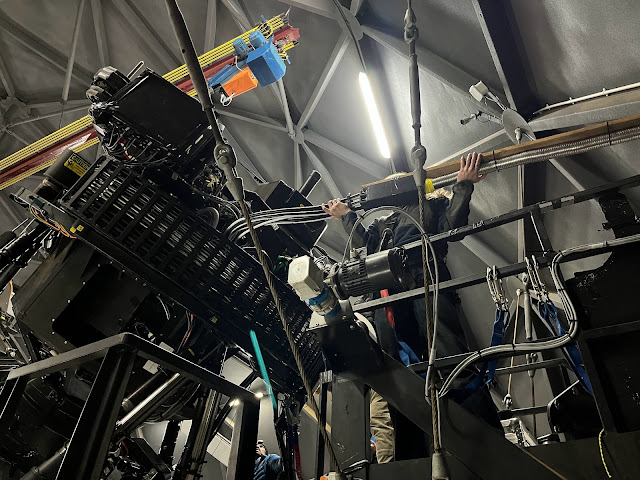First things first - a trip up to the catwalk for the interns to see what the Tech Ops team is doing - all perched precariously on the tracker while still routing the fibre cables through the rho wrap.
Then back to the core mission of terrorising poor Moses!
Unfortunately things weren't going well with the main compressor for the NIR enclosure - it kept cutting out & so the cooling process wasn't anywhere near where it ought to be by this stage. Eben & Mike climbed in & found the problem: the glycol line was completely plugged up with muck from the pipes that'd been blown loose by air in the system, as a result of issues caused by all the load-shedding. Eben did some impressive wall & floor art while bleeding the air + lots of crusty bits out of the system, before installing a strainer in the line & getting the cooling going again.
Up top they got all the cables into the wrap & then it was time to route the IFU end into the payload.
They kept the protective metal trunk in place for as long as possible.
Only removing it when the break-out box was in position & they could extract the two gooseneck conduits that protect the object & sky bundles.
Mike & Joshua then got the rocker mechanism + object & sky bundles installed in the FIF. Bryne isn't texting while that's happening, he's actually controlling the FIF stages with a VNC session on his phone!
Snug as a bug - the fibre break-out box in position on top of the tracker, just inside the rho ring.
The flexible silver conduits carrying the object IFU & the sky bundle go over the RSS space frame before entering the FIF bay through a hole in the roof of the rotating structure, the same entry point used by the HRS fibres (although those go in underneath the RSS frame).
By 9pm the enclosure was about halfway to where it needed to be...
But there was still plenty of work to be done to complete the safe routing of the rest of the cable & then securing it to the various attachment points on the telescope structure.
Then running the tracker around to check that the cable moves as it should & won't snag anywhere.
By around 01:40, with the enclosure at temperature at last, the team directed calsys light from the neon arc lamp into the fibres (without the grating in the beam, so just in straight imaging mode) to check that they're all alive & well...
To everyone's Absolute Delight, no one more so than Joshua, they all look Perfect!! The 8 V-groove blocks are beautifully aligned & every fibre lit up exactly as it should 😍 The dark gaps are the boundaries between the V-groove blocks & while the focus could be improved a bit (an easy enough thing to do), this is enormously good news! 😎
The extensive audience was suitably impressed!
Marsha then inserted the grating & took an arc, producing a couple of bright emission lines - the slightly curved vertical lines visible in the image below. The multiple straight vertical bands are from the various amplifiers within the infrared array (the detector).
Next up was the flat-field (QTH) lamp, also with the grating in the beam. It was a pleasant surprise to see how much NIR light the current calsys actually transmits! The cut-off at the left-hand edge of the image below is where the liquid light guide in the calsys stops transmitting at the red end.
The image below is a zoomed in view of the QTH flat, clearly showing 2 of the 8 V-groove blocks worth of continuum traces, taken with the grating at 25 deg, the instrument's bluest setting.
At this point it's fair to say We Have A New Spectrograph! With all of its fibres in Great shape - YAY!!
The humidity prevented us from going on-sky tonight, but tomorrow's weather forecast looks more promising, so stay tuned!



















Comments
Post a Comment